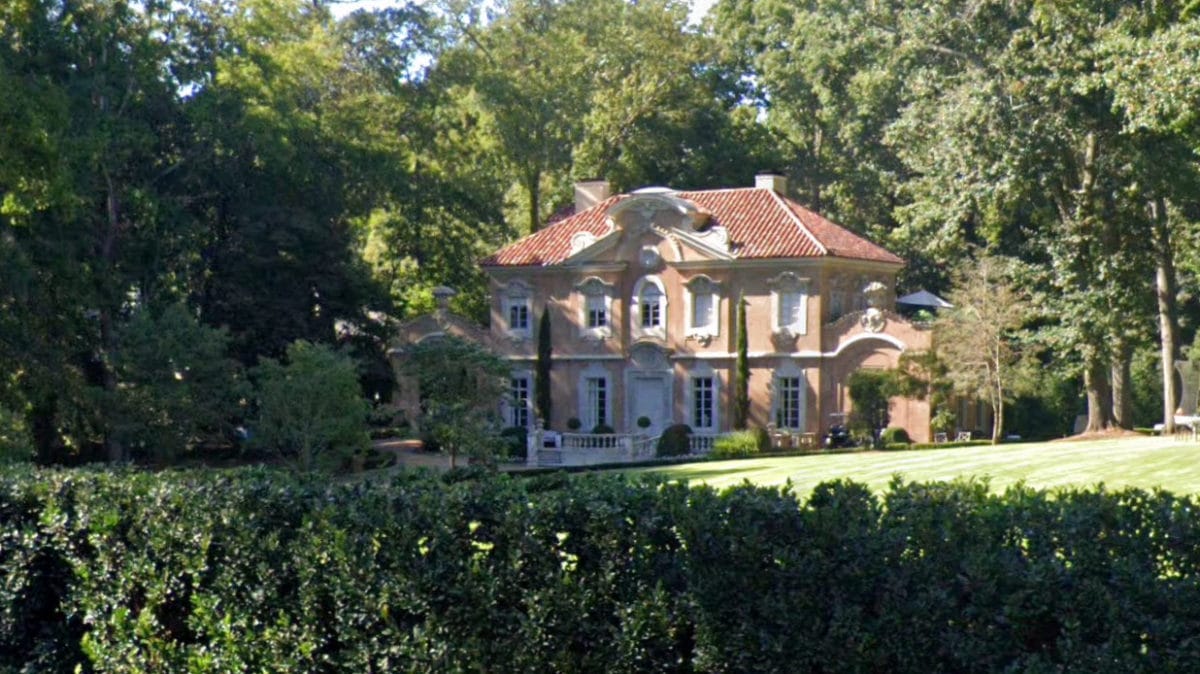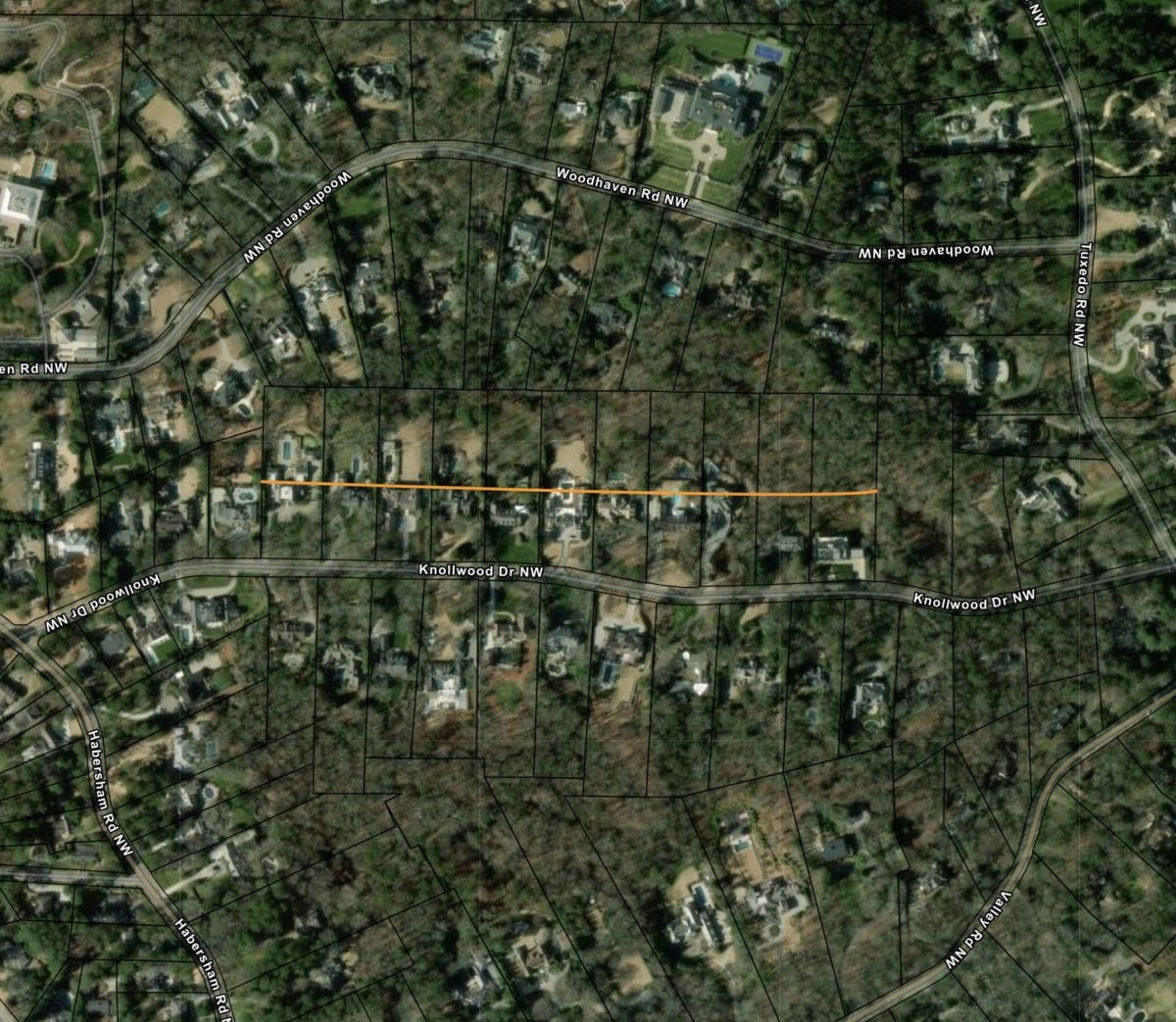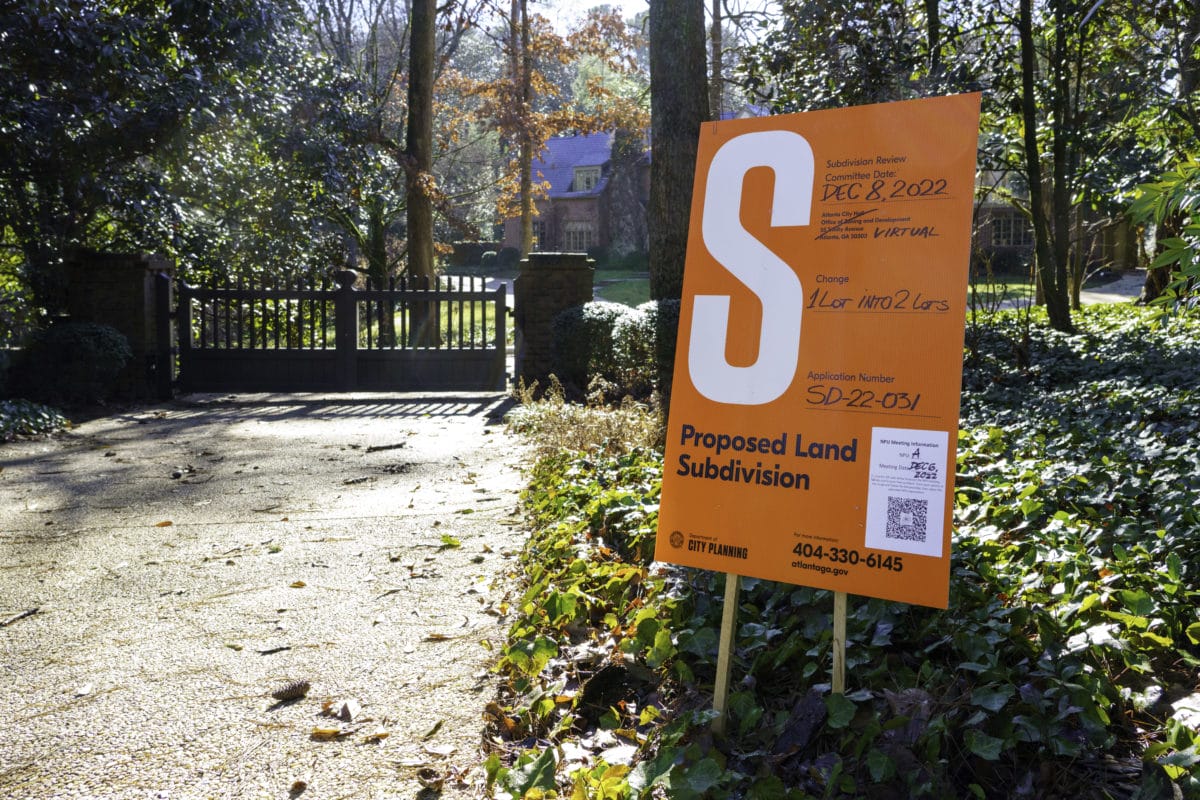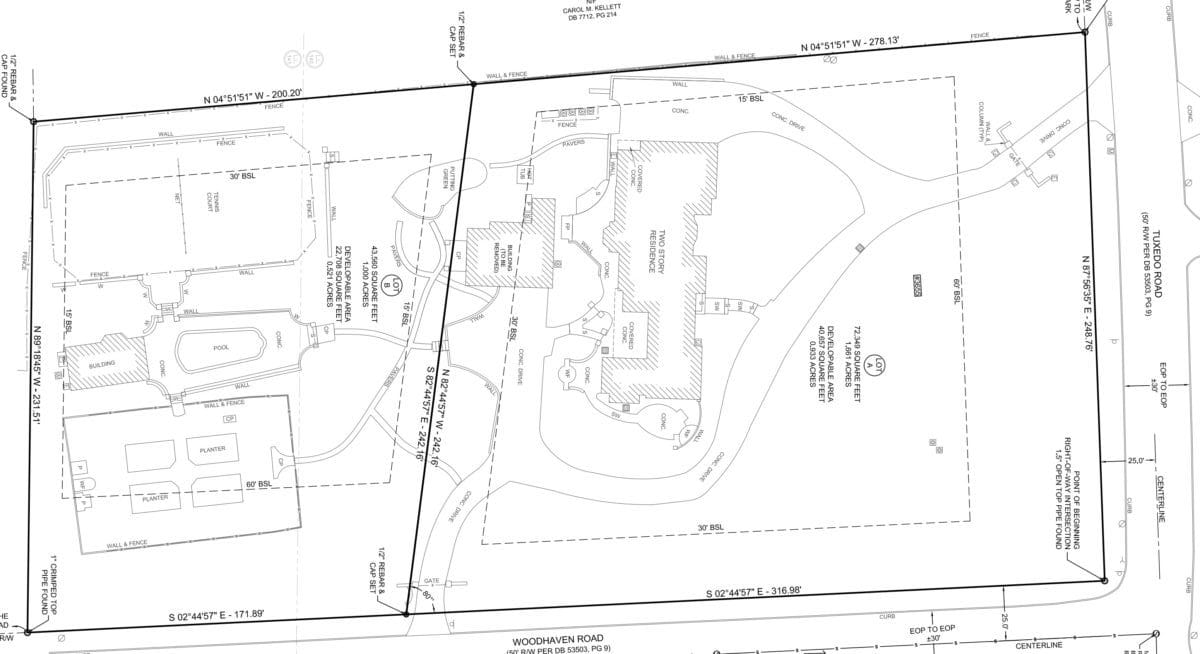Buckhead’s Tuxedo Park has long sought to draw a line in the sand against subdividing lots in the neighborhood. But a local developer is trying again, and it is a showdown that may be a defining moment for both sides.
Benecki Homes is seeking to subdivide 3655 Tuxedo Road, at the corner of Woodhaven Road, into two lots. The existing lot contains a Tudor-style home dating to 1929. The new lot would be drawn on what is now a swimming pool and tennis court that face Woodhaven. The existing lot is 2.66 acres and, like most of the neighborhood, is zoned to allow lot sizes as small as 1-acre. Subdividing the lot would comply with all zoning requirements, but that did nothing to convince neighbors who joined in on a recent NPU Zoom meeting to not oppose the plans. It was voted down 58 votes to 1. The applicant, Stan Benecki, was the lone “yes” vote.
The proposal “does not conform to the recognized ‘historic character’ of the Tuxedo Park neighborhood,” argued Gloria Cheatham of the Tuxedo Park Civic Association (TPCA) in a letter to the Atlanta Department of City Planning (DCP). Exactly who is able to define and determine what the elusive definition of “Historic Character” means is what makes this story so interesting. Whether this subjective standard can supersede zoning code is soon to be determined. It turns out this is a story dating back 100 years.
1911-1923 Tuxedo Park is born and a building boom ensues

Mass production of the automobile and a streetcar connecting downtown Atlanta with Buckhead resulted in a development boom. Developers carved up estates that had been on hundreds of acres into residential lots.
The idea of Tuxedo Park was conceived by a developer and a real estate agent who purchased 600 acres later developed into the Tuxedo Park neighborhood.
Dodie Stockton recounted in a history of the neighborhood how it came to be: “My grandfather was Charles H. Black Sr. He took great pride in telling his version of the acquisition of 600 acres north of Atlanta. He had lost a large sum of money in the Florida real estate market and returned to Atlanta in 1911. He borrowed a Cadillac automobile and a chauffeur and he went and got his banker friend and took him to ride and borrowed the money to purchase 600 acres which was a little bit north of Atlanta. He lived on that 600 acres all of his life and the 600 acres became Tuxedo Park.”In 1923, Charles Black Jr. joined the family development business as a builder and real estate agent. He constructed a large Tudor home for his family to demonstrate to potential clients what he was capable of building. This home still stands at 225 Valley Road, on the corner of Tuxedo Road. Tuxedo Park soon became a neighborhood of choice for wealthy families of the day and remains so to this day.
1950’s to 1990’s more development
From the 1950’s through 1990’s, several new cul-de-sacs were developed in the center of the neighborhood with most lots coming in just above the 1-acre requirement. Dozens of lots were carved off larger estates throughout Tuxedo Park, and many new landmark homes were built on them. Values in the neighborhood continued to soar.
1989-1990 A historic district is proposed
Between1989-1990 a proposal was created to have Tuxedo Park listed as a “Historic District” by the National Register of Historic Places. Some residents were opposed to the plan, concerned about the possible loss of property rights. They hired Carl Westmoreland to lobby against the designation, while Mary Norwood (then President of the TPCA) rallied support for the designation. Ultimately, the Atlanta City Council rejected the plan and it was never taken up again. “We had 400 in support of the proposal and only a handful opposed, but they had connections down at city hall,” said Norwood. In the years that followed, a group of neighbors often sought to deny subdivisions in and around Tuxedo Park. Resident and eventual City Council member Mary Norwood often led the charge. In cases where a proposed subdivision fit the zoning code, the developer usually prevailed.
2018 Drama at the Pink Palace

In 2018 the “Pink Palace” on the corner of West Paces Ferry Road and Tuxedo Road received approval for a subdivision of its 3.5-acre lot into three lots. Two new lots of almost exactly one acre on either side of the existing 1926 Baroque mansion were approved by the City of Atlanta. This defeat was bitter for the opponents of subdivisions and galvanized their resolve. They needed to change the rules or make some new ones.
2020 Opponents of development notch a major win
In 2020, the opponents of development in Tuxedo Park finally got their big break. The owners of a home on 3.4-acres at 3460 Tuxedo Road filed an application to subdivide the property into two lots. The subdivision went through the normal process of checks and balances. The TPCA submitted a letter in opposition.
On January 17th, 2020, Doug Young, Assistant Director of the City of Atlanta Office of Design and Historic Preservation, issued a determination; “In general, neighborhoods that are eligible for the National Register of Historic Places should be 50 years or older….Staff found that there were not enough remaining houses 50 years old or older to make the neighborhood eligible. Staff finds that the Tuxedo Park neighborhood, as it exists today, would not meet the criteria for being considered historic for the purposes of the City’s subdivision review process.”
With this determination, the subdivision application at 3460 Tuxedo Road was set to sail through the rest of the process. But then things went from procedural to political.
After a four-week behind-the-scenes campaign by subdivision opponents and some political machinations, a new letter was issued by Doug Young overturning his previous decision. A revised neighborhood map of homes and their ages had been developed with input from the TPCA which had calculated 53% of the homes in the neighborhood being 50 years old or older (a previous study by the applicant had claimed to show otherwise). In addition, the Office of Design Staff had taken a drive through the neighborhood to complete what they called a “windshield assessment”. Based on that car ride, and new map boundaries, Tuxedo Park would now be considered a “Historic Neighborhood” by the Office of Design based on their determination that it was now “Eligible to be listed on the National Register Of Historic Places”. Importantly, this gave individual city planners wide berth to deny subdivisions – even if they comply with zoning laws – based on their interpretation of whether the new lots would conform to the “historic layout, patterns, and design”.
Once Doug Young issued the letter stating the neighborhood had a historic designation, the zoning became secondary. The subdivision at 3460 Tuxedo was denied because “a side lot lines with an angle” was present on one of the two lots. Doug Young rejected the subdivision because “the vast majority of the existing lots in the neighborhood do not include such a configuration.”
According to Carl Westmoreland, the veteran zoning attorney who represented the applicant and helped defeat earlier attempts to list the neighborhood on the Historic Register: “The City’s position is that the City can determine “eligibility” as Mr. Young attempted to do is not consistent with federal regulations. Part 60 of Title 36 of the Code of Federal Regulations authorizes the Secretary of the Interior to maintain the National Register of historic sites and establishes the process and criteria to be followed in doing so. The regulations are explicit that eligibility for inclusion in the National Register is the sole province of the Keeper of the National Register of Historic Places.” While the owner of 3460 Tuxedo is appealing the denial in court, the Tuxedo Park Civic Association finally had the “win” that had eluded them for so long.
2023 Back to where this started
While Benecki’s recent subdivision application at 3655 Tuxedo was soundly defeated at the NPU level, that vote is merely an indicator to the city of how the neighbors feel. City planners are still bound to follow laws and zoning code in making their determination. Just three days after the NPU vote, Matt Adams, Assistant Director of the Atlanta Office of Design – Historic Preservation, issued a ruling to approve the subdivision proposal. Even when viewed through the “Historic Character” lens, which Gloria Cheatham of the TPCA had successfully argued was now a precedent, Adams found the proposed rectangular lots were larger than approximately 35% of existing Tuxedo Park lots and as such “would conform to the existing neighborhood’s layout, patterns, and design”. This effectively set Benecki up for final approval of the subdivision and he immediately started site preparations that were listed as city conditions for such approval, including tearing down a carriage house that straddled the new boundary line. Unbeknownst to him, things would soon take a familiar turn.
While Mary Norwood contributes the tireless energy and political connections for subdivision opponents, it is Gloria Cheatham, past president of Tuxedo Park Civic Association and retired attorney, who has proven to be their greatest asset in recent years. Cheatham brings an art of persuasion so convincing that city planners wither under the weight of her letters, opposition lawyers struggle to keep pace with her oral arguments, and developers marvel at her ability to make her point. It was one of her signature letters on January 3, 2023 to Matt Adams that once again turned this issue back in favor of subdivision opponents. Across the five-page letter Cheatham argued that, although the new lot created by Benecki did fit all other criteria, it was simply not long enough (her emphasis, not mine) to fit the pattern of the neighborhood.
Matt Adams issued a new determination on January 6th; the subdivision would be rejected because the new lots would not be long enough to conform with the neighborhood’s “layout, patterns, and design”. No definition of what would be “long enough” was provided.
Benecki received the news, an unwelcome surprise to him, just as he was finishing demolition of the carriage house on the property. “I bought this property for $4 million based on the understanding that it could be divided into two lots,” he told me. “How can they say this lot is too small for the neighborhood when it is larger than 35% of the existing lots?”
New Zoning Introduced At City Hall
While Benecki has not made it clear what his next steps will be with the property and whether he will challenge the ruling, the indefatigable Mary Norwood is already doubling down. Perhaps aware of the tenuous footing on which these recent subdivisions have been rejected, she submitted “Walk-In Legislation” three days later to the Zoning Committee of the Atlanta City Council. Her proposed legislation would establish new zoning restrictions applicable only to Tuxedo Park. Using a new concept called “zoning strings”, the legislation would enact the following rules in Tuxedo Park:
- All newly created lots must have depths that are at least twice the length of the width.
- The front half of each new lot will be covered by a building setback. Any construction or improvements must happen on the back half of the lot only.
The effect of these two rules combined is that any new lot of record would have to be at least 300 feet deep and would have a front building setback of at least 150 feet. The most restrictive front setback in the current zoning code is 60 feet.
In a video recording of the Council meeting on January 9th, six Council members and city staff meet in the otherwise empty chambers. Around 22 minutes into the meeting, Norwood’s proposal to revise the zoning code for the neighborhood is read out and she calls for a vote. After the vote, which was unanimous in favor, Council member Matt Westmoreland speaks up, “Actually, we will need to reconsider this because what we should do… this committee shouldn’t approve it yet. We need to send it to the ZRB (Zoning Review Board) and NPU, so I m sorry I’ll have to ask you to reconsider.” The full committee then votes unanimously, again, to rescind their approval and to send the proposal for review and public comment to the ZRB and NPU-A. The NPU meeting will be March 7, 2023 07:00 PM (the original meeting February was delayed), Click Here to register and join the meeting. The ZRB will take up the issue at a meeting on March 9th at 6pm in city hall council chambers. If the proposed legislation makes it past these two boards then it would go for a full city council vote that could make it law.

While this story has spanned decades and has had numerous twists and turns, it clearly is not over yet. For Mary Norwood, passage of her legislation would make it almost unfeasible for anyone to develop additional lots in Tuxedo Park due to the unprecedented setback requirements. She would finally have the victory she has been after for 33 years. The consequences could be more far-reaching than intended. While a seeming boon to NIMBY’s, a neighborhood-by-neighborhood patchwork of zoning regulations would have a chilling effect on future development, additions, and renovations throughout Buckhead and across the City of Atlanta.
The issue at stake almost always boils down to two perspectives: Property owners who wish to exercise their private property development rights to capitalize on millions of dollars in potential profits that a lot in Buckhead can bring, versus those who see new lots being created in the neighborhood as a threat to its historic character and their enjoyment of it. We may soon know which one will prevail.
Authors note: I have a particular interest in the issue of land use, zoning, and private property rights in Tuxedo Park. While I have never had any ownership in any subdivision process, I have owned multiple homes in Tuxedo Park and have brokered countless sales in the neighborhood for clients on all sides of this issue. Despite this web of relationships that are inevitable, I have made every attempt to be fair in my reporting on this issue.






